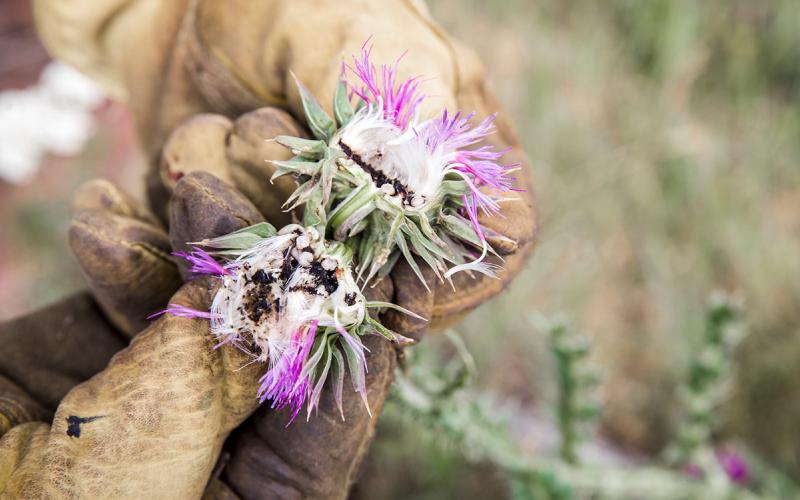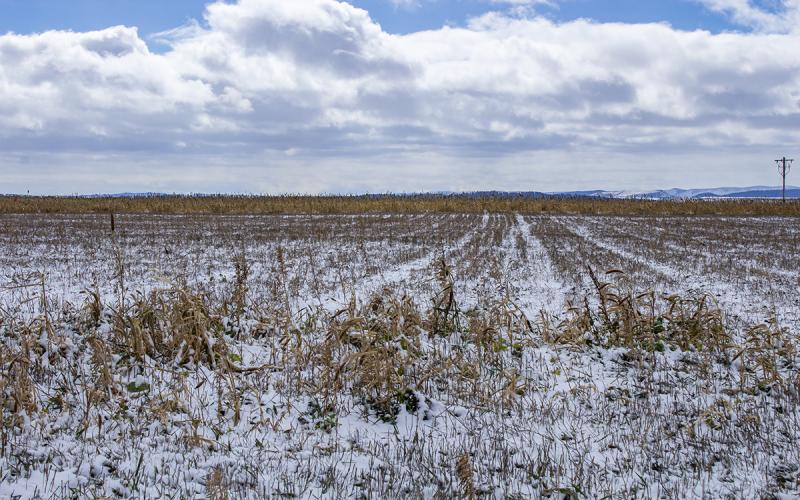Written collaboratively by Eric Jones, Philip Rozeboom, Jill Alms, and David Vos.
What is the Critical Period of Weed Control?

The critical period of weed control (abbreviated as CPWC) is the period during a crop lifecycle when weeds need to be managed to avoid a significant yield loss. The CPWC consists of two components; weed-free period (amount of time weeds end to be controlled; from planting to weed emergence) and weed removal timing (amount of time the crop can withstand weed competition). These two components are graphed based on yield loss and time. Where the weed-free and weed removal timings intersect at a specified acceptable yield loss (usually 5% yield loss) determines the critical period of weed control (Figure 1). Based on the example in Figure 1, the CPWC happens 3 to 6 weeks after crop emergence. Again, this duration is when the crop needs to be weed-free to ensure no yield loss. The CPWC varies for different crops. Table 2 provides a summary for the CPWC for major crops grown in South Dakota. Generally, a precise, critical period of weed control is specified in growing degree units but generalizations of weeks after planting/emergence or crop stage can be accurate as well.
| Crop | Critical period of weed control | Source |
|---|---|---|
| Corn | 3-leaf (V3)/6-leaf (V6) to 10-leaf (V10)/; | Hall et al. 1992; Halford et al. 2001 |
| Soybean | 2-trifoliate (V2) to flower blooming (R1)/pod development (R3) | Halford et al. 2001 |
| Wheat | 10 to 18 weeks after emergence | Contreras 2020 |
| Sorghum | 2 weeks to 5 weeks after planting | Contreras et al. 2022 |
| Sunflower | 3-leaf (V3) to inflorescence opens/flowering(R4-R5) or at planting to 8-14 weeks after planting | Hodi et al. 2006; Stefanic et al. 2023 |
Weed Management Impacts

While the CPWC provides a sound guideline for managing weeds to ensure there is no significant crop yield loss, the research conducted to determine these periods in various crops did not account for all the external variables that encompass production practices. Practices such as crop rotation, row spacing, and tillage can affect the duration of the CWPC. While the general guideline of the CPWC for each crop can be followed, other external factors outside of control (i.e., temperature, rain, wind) can increase the difficulty to meet the general guidelines for management timing. Weed species, density of weeds, and the emergence timing of the different weed species also influence the CPWC. Management tactics should be selected that are effective on the weed species present in the field, otherwise even the timely implementation of the management tactic will be ineffective.
Additionally, the application of various herbicide(s) can influence the CPWC. The application of preemergence herbicides can delay the weed removal timing, the result is the delayed timing of postemergence weed management. Postemergence herbicides that have soil residual activity help extend weed management within the CPWC to control later emerging weeds. While later emerging weeds (outside of the CPWC) do not decrease yield directly, these weeds can produce seeds to be managed in future growing seasons and interfere with harvest efficiency. The use of preemergence and postemergence herbicides with soil residual activity can decrease the amount of postemergence herbicide applications. Reducing the number of herbicide applications is important to reduce the selection pressure on herbicide resistant weeds. The CPWC does not consider managing herbicide-resistant weeds; the CPWC assumes that weeds are controlled. While herbicide-resistant weeds can be managed, complete control is likely not achieved; this statement is true for herbicide-susceptible weeds as well.
While the CPWC is far from perfect, there is still merit in using the general durations for each crop to ensure weeds are being managed at the correct timing. While herbicides are easily applied to meet the guidelines for the CWPC, other tactics aside from herbicides should be utilized to manage weeds. While the non-chemical management tactics (i.e., tillage/no tillage, row spacing, crop rotation) can influence the CPWC for each crop, utilizing the various tactics will likely align and help protect the crop yield potential from weed competition.
References
- Contreras DJ (2020) Critical period of grass weed control in grain sorghum (Sorghum bicolor) and wheat (Triticum aestivum) (MS thesis). North Carolina State University.
- Contreras D, Leon RG, Post AR and Everman WJ (2022) Critical period of grass weed control in ALS-tolerant grain sorghum (Sorghum bicolor) is affected by planting date and environment. Front Agron 4:1014801
- Halford C, Hamill AS, Zhang J, Doucet C (2001) Critical period of weed control in no-till soybean (Glycine max) and corn (Zea mays). Weed Technol 15:737–744
- Hall MR, Swanton CJ, Anderson GW (1992) The critical period of weed control in grain corn. Weed Sci 40:441–447
- Hódi L, Torma M, Mucsi K, Kazinczi G (2006) Critical periods for weed control in sunflower in South-Eastern region of Hungary. Cereal Research Communications 34:469–7.
- Stefanic E, Rasic S, Lucic P, Zimmer D, Mijic A, Antunovic S, Japundzic-Palenkic B, Lukacevic M, Zima D, Stefanic I (2023) The Critical Period of Weed Control Influences Sunflower (Helianthus annuus L.) Yield, Yield Components but Not Oil Content. Agronomy 13:2008
- Van Acker R, Swanton C, Weise S (1993) The critical period of weed control in soybean [Glycine max (L.) Merr.]. Weed Sci 41:194–200


